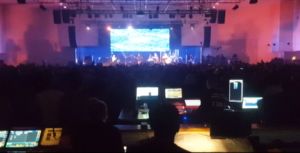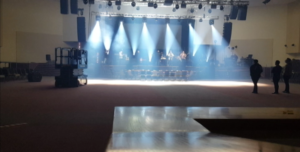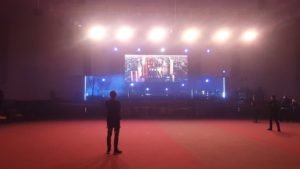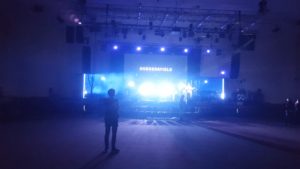I arrived at 8:00am for the load in as an in house tech for Huddersfield Christian Fellowship. I’ve gone off live sound a bit following some work with a band that shall remain nameless, but this day was refreshing. Bethel was touring for Big Church Live, the same promoter as with my last involvement in a big live event, so it was nice to see some familiar faces there. The equipment for the tour was provided by Wigwam and they also provided a number of engineers, monitor and system tech among others. Bethel brought their own engineers on the tour as well to mix monitors and front of house. I’ve found that this always sounds better than when someone who doesn’t know the sound of the band as well. The monitor technician as provided by wigwam happened to be part of my church, Dave Orridge.

Infrastructure, obviously the big things went in first, we flew a truss underneath the in house truss for Bethel’s lighting fixtures so we didn’t need to de-rig any of HCF’s lighting rig. We also raised 2 towers on stage to act as the back of the stage, from this we hung black curtains and a modular screen. Finally we flew 2 line arrays from some spare mounting points between the in-house truss and line array. The line arrays we used have a great design, for anyone who uses touring systems this will be familiar. Touring rigs work on a latch and pin system, the angle between the segments of the line array are determined by the number of pins you let the latch go up; this means you can very quickly put up arrays that are angled specifically for the venue you are in. By contrast, the in house line arrays are bolted together making them difficult to change. All of the cabling for the line arrays were trailed of the back of the speakers down to the amplifier racks that were directly below. Across the front of stage were 5 sub-woofer cabinets and on top of each of these was a front fill. We had to rotate the horns in the front fills to change the dispersion from vertical to horizontal. This was a simple job unless you moved the speaker to far within the housing and you got the speaker magnet stuck to rear of the cabinet; this didn’t happen to me personally but it was entertaining watching someone attempt to pull it out without getting it stuck to something else and without wrenching one of the cables out. Finally we also used side fills, these were the only speakers actually on stands throughout the whole venue.
The multicores were run from the stage to back of house around the side of the room, we made use of the balcony to run over to the center of the room without creating a trip hazard. I hoisted the snakes up one at a time and tied them down to the front edge of the balcony and trailed them down into front of house where they connected to the lighting desk, and the Front of House Desk. The desks at both Front of house and monitors were DiGiCo SD10s, both using Waves Multirack to run plugins. The monitor set up was fantastic, everyone was using stereo in ears and there wasn’t a wedge monitor in sight, the stage looked very clean as a result of this. I was surprised at the choice of microphones though, specifically the use of Neumann KSM105s. They sounded fantastic but I was expecting them to use wireless microphones. Everything else was fairly standard, they used Shure 545SD’s on the guitar amplifiers and some standards on the kit. The backline was world class. There were 3 electric guitar rigs used; two of them stereo and one mono. The first was comprised of 2 limited edition Vox AC30s, the second an AC30 and a Fender Deluxe Reverb and the final one was just a single Fender Deluxe Reverb. The pedal boards were something else as well, you can see a glimpse of them in this post from Bethel Music’s Instagram page.
The use of lighting was great, it worked well through the whole show, adding massively to the experience. The lighting engineer was very talented, a lot of the time he used lights to emphasize different notes. Bellow are a few pictures showing how good the lighting was on the day


I spent a bit of time talking with the front of house engineer about his drum processing. It sounded incredible, particularly the snare, he was using gated reverb but layered compression on the snare, compression on the drum bus, some parallel compression. The flexibility afforded to him by the SD10 enabled him to run a lot of different processes in parallel. He not only used gated reverb but a short and a long kit reverb time as well adding to the layers that made the sound. On the plugins front, he made a lot of use of the SSL G channel by Waves and the C6 multi-band compressor.
The band were very good natured and were great to interact with. Even after breaking a string in sound check on the first day of their tour, Hunter, one of their singers, was able to shrug it off as just life. Things can be stressful when going for perfection, especially on the first day when everyone is still working out some wrinkles but everyone was happy and giving glory to God.



0 Comments